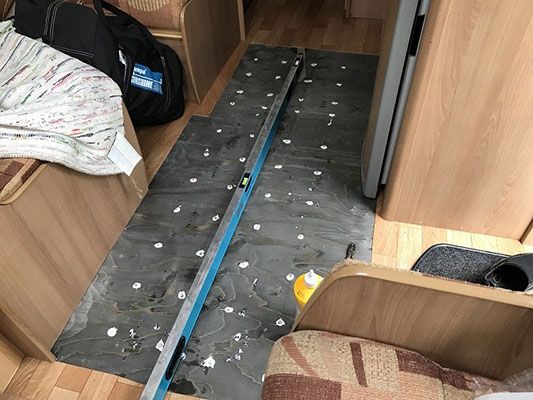Whether you are a veteran tourer or a novice to caravan ownership, there will be problems that arise that affect your caravan. Although not all issues are severe, delamination is one of the most common problems that can affect your caravan.
You might not have known it was called, or you might have noticed that your floor makes some strange sounds.

Caravan Floor Delamination
What Is It?
It is important to know that the flooring in a caravan consists of three layers: a layer of plywood, a layer of Styrofoam insulation, and a layer of plywood. When the glue used to join these materials begins to wear away, this is called delamination. It is more noticeable in areas that are used most often.
Delamination is the technical explanation, as the glue that holds the various layers together begins to wear away.
The floor is typically made up of three layers: flooring plywood on top and plywood on the bottom. This is separated by Styrofoam insulation.
They are held together by a special glue, which over time becomes weaker and starts to separate.
It will occur in the areas that you are more familiar with, but it can spread to other areas if it isn’t addressed.
Water damage can cause spongy floors in caravans. These are some ways flooring can be damaged:
- Water Damage From a Plumbing Leak
- Moisture is entering the caravan from outside
- Water in
- Poor Insulation is Producing Interior Humidity
- Leaks Caused by Poor Construction in Older Campers
Where’s The Water Coming From?
It is easy enough to identify that your spongy floors are caused by moisture. The hard part is identifying the ‘source’ of the water damage.
Even though caravans are built to withstand the elements, there are still ways water can enter your caravan and do its damage. Here are some of the most common ways water can enter your caravan and how you can identify them:
You May Be Interested In: Leaking Caravans: How To Seal Them Properly
How Can I Fix Caravan Delamination?
Although repairing caravan floors is not an easy task, it is possible with a bit of patience and precision.
If you are not an expert in carpentry, it may be easier to hire a professional. To replace a complete floor, professional assistance is required.
Here’s what to do if you are up for the challenge:
The first step is to determine the extent of the damage. The best way to do this is by looking at the floor inside your caravan. If there is any delamination, you’ll be able to see it quite clearly.
- Remove the carpets – dry out if necessary
- Drill holes where the delamination has occurred. The holes should be approximately 10cm by 10cm. The holes must pass through the plywood top layer and the Styrofoam insulation. Be careful not go through the exterior plywood layer.
- Use a special adhesive to fill the gaps. You can search Google for “delamination repair kit” to find a variety of solutions on Amazon and eBay. It is a gluey substance, which hardens after you use it. This creates a strong support structure.
Blue Diamond Screw Tent Pegs – 20 pack, Purple, One Size

- Compatible with Cordless Drill and Pegs ‘Screw-In’ Requires 13mm Drill Adaptor
- Corkscrewed Shaft for Extra Grip
- Fantastic on Hard-Standing or Shaley Ground
- Heavy-Duty Plastic Head to Firmly Grip Guylines with 13mm Bolt Head
- Includes Robust Plastic Carry Case with 20 Pegs Inside
- Insert wooden dowels – these must be exactly the same size as the holes you have created in width and depth. After applying the adhesive, insert them in the holes so that they fit perfectly.
- Any glue that has escaped is to be cleaned up. You can then re-fit the carpet.
Your floor will look brand new again after that. It will actually be even better because the wooden dowels will give it additional support!
Defect Repair – Hire A Professional
While more expensive, this means you don’t have to deal with the problem by yourself!
It is possible to hire a professional caravan repair company or a person who has extensive experience dealing with delamination. This is a significant weight off many people’s shoulders.
This can come at a cost. Depending on how severe your delamination problem is, you could pay between £50 and £150 an hour.
Although you can save considerable money by tackling the problem yourself, it is still advisable to hire a professional if your caravan requires extensive renovations.
Protect Your New Floor From Future Water Damage
After you have installed your floor, it is important to make sure that it does not become damaged by water in the future. After your floor has been installed, you can use an End Grain Sealer to protect your entire floor.
You can seal your subfloor and floor seams to prevent water from entering the subfloor.
Osmo End Grain Sealing Wax 5735 0.375ltr by End Grain Sealing Wax

- Protects edge grain of decking against cracks
- Prevents wood ingredients from bleeding
- High weather resistance
- Very water and dirt resistant
- Minimises wood swelling and shrinkage
How Can I Ensure That My Caravan Floor Will Remain Dry?
Keeping the doors of your caravan closed as much as possible will help prevent moisture and humidity from getting in when it rains. It will also prevent moisture from getting in when you are using the shower, cooking or doing laundry inside your caravan.
Only open the windows when you need some air circulation inside your caravan. Closing windows during bad weather is also recommended as this will prevent rain from getting in through cracks and openings in the roof, doors and windows of your caravan.
Its also a good idea to have some kind of canopy or awning pitched, which will help keep the rain off the door during your stay.
These are a few tips which may help, but unfortunately, there is no way hard and fast way to prevent water damage in your caravan. Water issues can occur just like in a traditional home.
Do Your Checks Before You Go Touring
Water ingress is something you will always worry about whether you are buying your first caravan or you’ve been touring for years.
The first thing you should do is to check the flooring and the area surrounding it. Look for any water leaks, and check the seals of doors and windows to make sure that they are in good condition.
Also, make sure that there are no holes or cracks in the flooring or anywhere else that moisture may seep through. If you discover any of these problems, get them fixed before you go touring.
Use a Moisture Meter
Another way to check for moisture is by using a moisture meter. This device can be used on any surface and will tell you if there are any areas where excess moisture exists. You can also use this tool to check under floors and other areas where dampness tends to gather.
If you’ve spotted some areas where water has entered the caravan and have a few basic tools and products like some gorilla tape to hand to stop further damage, you’ll be able to enjoy a worry-free touring trip.
Just get it fixed as soon as you can!

